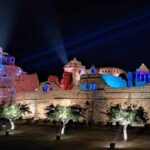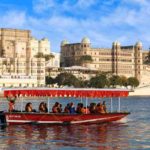How To Plan Rajasthan Trip requires careful consideration of various aspects. Start by deciding on your travel dates and the duration of your stay. Rajasthan is vast, so prioritize the cities and attractions you want to visit. Jaipur, Udaipur, Jodhpur, and Jaisalmer are popular destinations.
Next, book your accommodations in advance, especially if you plan to visit during peak tourist seasons. Consider staying in heritage hotels or havelis for an authentic experience.
Arrange transportation, whether it’s renting a car, hiring a driver, or using a combination of trains and buses. Rajasthan’s diverse landscape is best explored with a mix of modes.
Create an itinerary that balances sightseeing with relaxation. Explore historic forts, palaces, and vibrant markets. Don’t miss Amer Fort, City Palace, Mehrangarh Fort, and Jaisalmer Fort. Experience local culture through traditional dance performances and cuisine.
Pack appropriate clothing for the season. Rajasthan can be extremely hot in summer and chilly in winter. Don’t forget essentials like sunscreen, a hat, and comfortable walking shoes, Rajasthan Monuments.
Lastly, check for any travel advisories or entry requirements, and ensure you have all necessary documents.
With careful planning, your Rajasthan trip will be a memorable adventure through this culturally rich and historically significant region of India.
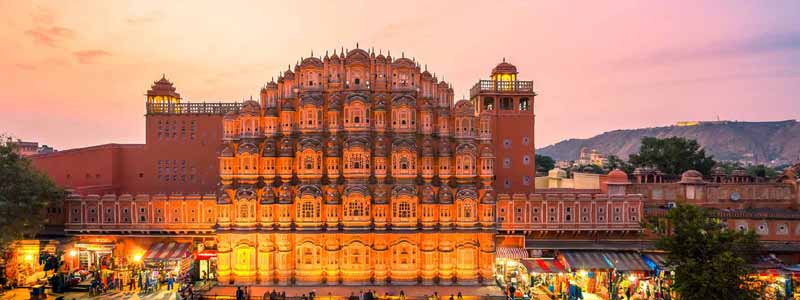
Jaipur
Jaipur, often referred to as the “Pink City,” is a vibrant and culturally rich city in the northern Indian state of Rajasthan. It’s renowned for its magnificent palaces, historic forts, bustling markets, and a blend of Rajput and Mughal architecture.
Amer Fort: This grand fort, situated on a hilltop, offers panoramic views of the city. Explore its intricate marble work, mirror mosaics, and the Sheesh Mahal (Hall of Mirrors).
City Palace: A splendid blend of Mughal and Rajput architecture, the City Palace complex houses museums, courtyards, and gardens. Don’t miss the Chandra Mahal, with its exquisite peacock gate.
Hawa Mahal: The “Palace of Winds” is an iconic five-story structure with honeycomb-shaped windows. It was designed to allow royal ladies to observe street processions while remaining hidden.
Jantar Mantar: This UNESCO World Heritage site is an astronomical observatory built by Maharaja Jai Singh II. It features a collection of architectural instruments designed for precise astronomical measurements.
Nahargarh Fort: Perched on the Aravalli hills, this fort offers breathtaking views of the city. It’s a great spot to catch a sunset.
Jaigarh Fort: Known for housing the world’s largest cannon on wheels, this fort provides a glimpse into the military prowess of the Rajputs.
In essence, Jaipur offers a fascinating blend of history, culture, and architecture. It’s a city where every corner is steeped in royal splendor, making it a must-visit destination for travelers seeking an authentic Indian experience.
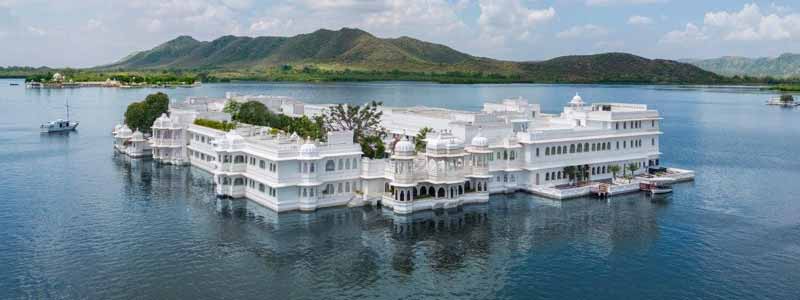
Udaipur
Udaipur, often referred to as the “City of Lakes,” is a mesmerizing city located in the Indian state of Rajasthan. Known for its rich history, stunning architecture, and picturesque landscapes, Udaipur is a must-visit destination for travelers seeking a blend of culture, history, and natural beauty.
City Palace: A magnificent complex of palaces, courtyards, and gardens, offering breathtaking views of Lake Pichola and the surrounding city.
Lake Pichola: This artificial freshwater lake is a central feature of Udaipur. Boat rides on the lake provide stunning views of the city, especially during sunset.
Jag Mandir: An exquisite island palace on Lake Pichola, known for its marble structures, intricate carvings, and lush gardens.
Jagdish Temple: A large and artistically significant Hindu temple dedicated to Lord Vishnu, known for its impressive architecture and intricate carvings.
Saheliyon-ki-Bari: A beautiful historic garden adorned with fountains, lotus pools, marble pavilions, and delightful flowerbeds.
Fateh Sagar Lake: Another picturesque lake in Udaipur, offering boating and stunning views of the surrounding hills.
Udaipur’s charm lies in its seamless blend of history, culture, and natural beauty. A trip here promises a unique and unforgettable experience for every traveler.
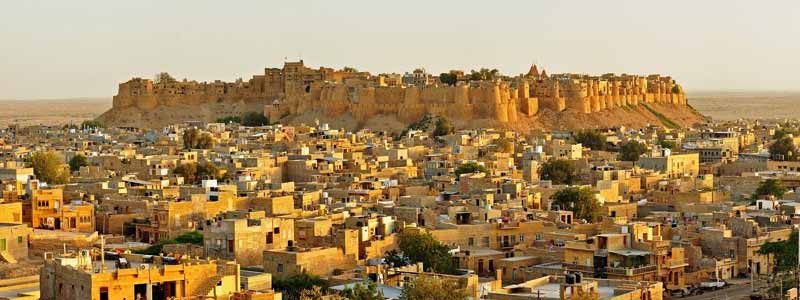
Jaisalmer
Jaisalmer, often referred to as the “Golden City,” is a mesmerizing destination in the heart of the Thar Desert in Rajasthan, India. Here are some of the top attractions in Jaisalmer:
Jaisalmer Fort: This UNESCO World Heritage Site is the crown jewel of Jaisalmer. Built in 1156 AD, it’s one of the oldest forts in Rajasthan. The fort is made of golden sandstone, giving it a distinctive golden hue, especially during sunset.
Patwon Ki Haveli: This cluster of five havelis (elaborate townhouses) is a remarkable example of intricate architecture. Each haveli is unique, showcasing intricate carvings, arches, and balconies. It offers a glimpse into the opulent lifestyle of the wealthy merchants of that era.
Sam Sand Dunes: Located about 40 kilometers from Jaisalmer, these dunes are a quintessential part of the Thar Desert experience. Visitors can enjoy camel safaris, dune bashing, and witness the magical sunset over the vast expanse of sand.
Gadisar Lake: Built in the 14th century, this artificial lake was once the primary water source for the city. Surrounded by ghats, temples, and chhatris (cenotaphs), it’s a serene spot to relax and take in the picturesque views.
Nathmal Ki Haveli: This haveli is a blend of Rajput and Islamic architectural styles. It was built by two brothers and showcases impressive craftsmanship. The highlight is the life-sized elephant sculpture carved out of a single piece of yellow sandstone.
Desert Culture Centre and Museum: This museum offers valuable insights into the rich cultural heritage of Rajasthan. It houses an extensive collection of artifacts, including traditional costumes, jewelry, instruments, and more.
Jain Temples: Situated within the Jaisalmer Fort, these temples date back to the 12th and 15th centuries. They are dedicated to different Jain Tirthankaras and feature remarkable architecture and detailed carvings.
Kuldhara Village: Often called the “Ghost Village,” Kuldhara is an abandoned village with a mysterious past. Legend has it that the residents cursed the village before leaving, which led to its eerie reputation.
Jaisalmer’s unique blend of history, culture, and desert landscapes makes it a must-visit destination for travelers seeking an authentic Rajasthani experience.
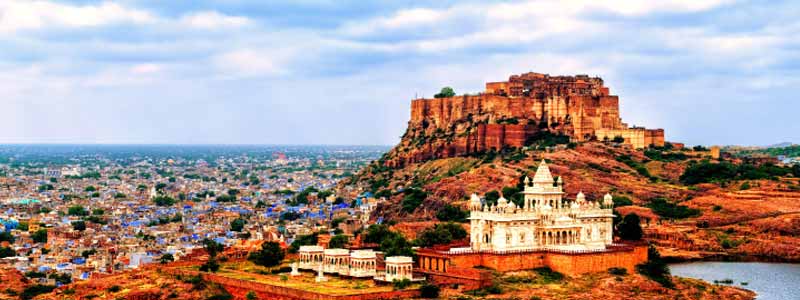
Jodhpur
Jodhpur, often referred to as the “Blue City” due to the striking blue-painted houses, is a city in the Indian state of Rajasthan known for its rich history, vibrant culture, and stunning architecture. Here are some of the top attractions in Jodhpur:
Mehrangarh Fort: Dominating the city skyline, this massive fort is one of the largest in India. It offers breathtaking views of Jodhpur and houses a museum with an impressive collection of artifacts, including palanquins, weapons, and textiles.
Jaswant Thada: This cenotaph, built in white marble, is a peaceful spot located near Mehrangarh Fort. It’s a beautiful example of Rajputana architecture and offers a tranquil respite from the bustling city.
Umaid Bhawan Palace: A blend of Indian and European architectural styles, this magnificent palace is still partially a residence for the royal family of Jodhpur. It also houses a museum showcasing the opulent lifestyle of the erstwhile rulers.
Clock Tower and Sardar Market: This bustling market is a great place to experience the local culture and shop for handicrafts, textiles, spices, and traditional Rajasthani attire. The towering clock is a prominent landmark.
Mandore Gardens: Located a short drive from the city center, these gardens are home to cenotaphs of the Marwar rulers. The beautiful temples and memorials amidst lush gardens make it a serene place to visit.
Rao Jodha Desert Rock Park: Spread over 70 hectares, this park is a unique initiative to restore and showcase the natural ecology of the rocky Aravalli terrain around Mehrangarh Fort. It’s a haven for nature enthusiasts and birdwatchers.
Mandaleshwar Mahadev Temple: Carved out of a single rock, this ancient temple is dedicated to Lord Shiva. It’s renowned for its intricate architecture and religious significance.
Osian Temples: Located about two hours from Jodhpur, these ancient temples date back to the 8th century and are a testament to the architectural prowess of the bygone era.
Exploring Jodhpur’s attractions allows you to delve into the history and culture of Rajasthan while marveling at its architectural grandeur. Don’t forget to indulge in the local cuisine, known for its flavorsome dishes like dal baati churma and mirchi bada.
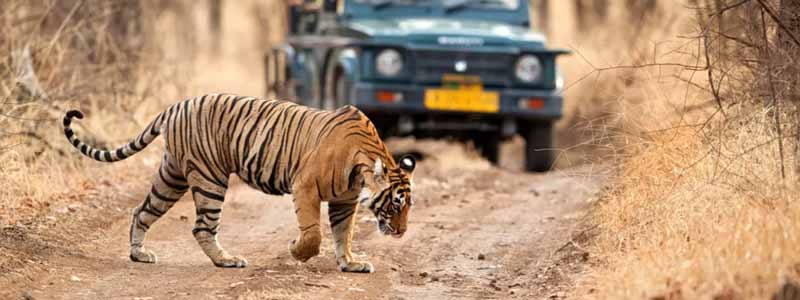
Ranthambore
Ranthambore, located in the state of Rajasthan, India, is renowned for its rich biodiversity and, most notably, its thriving population of Bengal tigers. Here are some of the top attractions in Ranthambore:
Ranthambore National Park: This is the star attraction of the region. It’s a vast wildlife sanctuary spread over 1,334 square kilometers. The park is home to a diverse range of flora and fauna, including tigers, leopards, sloth bears, crocodiles, and a variety of bird species.
Ranthambore Fort: Within the national park itself, this ancient fort is a testament to the region’s historical significance. It’s perched atop a hill and provides stunning vistas of the park and its surroundings.
Padam Talao: This is one of the largest lakes in the park and is famous for being a prime spot for wildlife photography. It’s a great place to witness a variety of bird species, especially during the winter months.
Raj Bagh Ruins: These ancient ruins are scattered throughout the park and add a mysterious charm to the landscape. They provide a glimpse into the history of the region.
Kachida Valley: This valley is known for its picturesque scenery and is a favored spot for nature enthusiasts and photographers. It’s an excellent location to observe wildlife, especially sloth bears.
Surwal Lake: Situated near the national park, this lake is another birdwatcher’s paradise. It’s frequented by a variety of migratory and resident bird species, making it an excellent spot for birdwatching.
When visiting Ranthambore, it’s essential to follow the park’s rules and regulations for wildlife conservation and safety. Engaging a local guide can enhance your experience by providing valuable insights into the flora and fauna of the region.
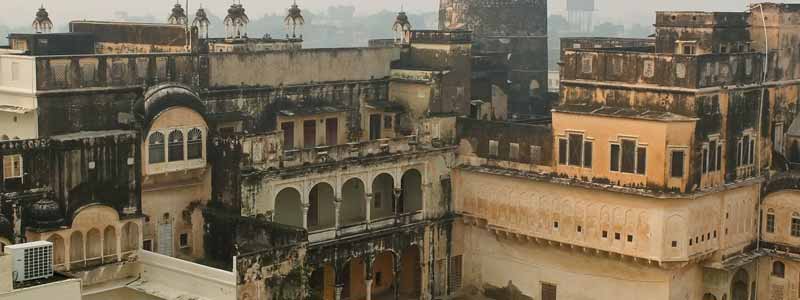
Mandawa
Mandawa, located in the Shekhawati region of Rajasthan, India, is a town steeped in history and known for its stunning havelis (ornate mansions). Here are some of the prominent attractions in Mandawa:
Mandawa Fort: Also known as the Castle Mandawa, this fort is a significant landmark in the town. It was built in the 18th century and houses beautiful paintings and artifacts. The fort’s architecture is a blend of Rajput and Mughal styles.
Thakurji Temple: This ancient temple is dedicated to Lord Krishna and is known for its stunning architecture and intricate carvings. The temple is an important religious site for the locals and a place of serene contemplation for visitors.
Bansidhar Newatia Haveli: One of the most celebrated havelis in Mandawa, it is renowned for its enchanting frescoes. The artwork here depicts a wide range of subjects, from mythological figures to scenes from daily life.
Murmuria Haveli: This haveli is a visual delight, featuring vibrant paintings that tell stories of historical events, royal processions, and folklore. The artwork is a testament to the craftsmanship of the artists of that era.
Goenka Double Haveli: This haveli is a twin structure adorned with remarkable frescoes. It’s a prime example of the artistry and architectural finesse prevalent in Mandawa.
Sakshar Mahal: This haveli has a unique distinction for being an educational institution. It houses a school and also boasts some remarkable frescoes.
Visiting Mandawa is like stepping back in time, where every wall tells a story and every corner exudes a sense of regality. It’s a must-visit destination for history enthusiasts and admirers of art and architecture.
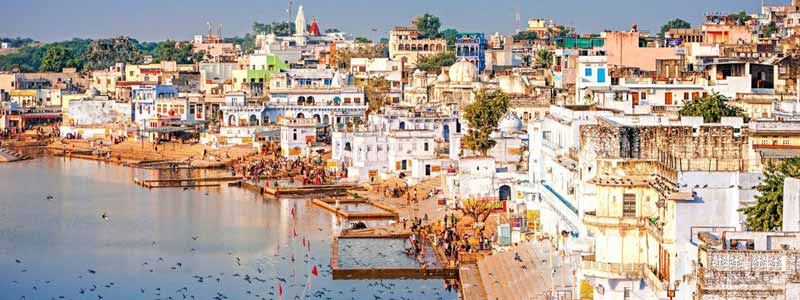
Pushkar
Pushkar, a quaint town in Rajasthan, India, is a magnet for both pilgrims and travelers seeking a unique cultural experience. Here are some of its captivating attractions:
Brahma Temple: This temple is one of the very few in the world dedicated to Lord Brahma, the creator in Hindu mythology. It’s an important pilgrimage site for Hindus and features a serene ambiance.
Pushkar Lake: Considered one of the most sacred lakes in India, Pushkar Lake is believed to have been formed by the tears of Lord Shiva. Pilgrims bathe in its waters, believing it cleanses them of sins.
Savitri Temple: Perched on a hill, this temple offers panoramic views of Pushkar and the surrounding desert landscape. It’s dedicated to Goddess Savitri, Lord Brahma’s first wife.
Pushkar Camel Fair: Held annually in November, this world-famous fair is a spectacle of vibrant colors, folk performances, and of course, a large number of camels. It’s a unique cultural event that draws visitors from around the world.
Merta: A short drive from Pushkar, Merta is a town steeped in history. It’s the birthplace of Meera Bai, a renowned saint and poetess, and houses the Meera Bai Temple.
Man Mahal: Located near Pushkar Lake, this palace was built by Raja Man Singh I of Amer and is now a heritage hotel. It offers a glimpse into the grandeur of Rajasthan’s royal past.
Rose Gardens: Pushkar is known for its production of fragrant rose products. Visit one of the many rose farms to see the process of making rose water and other products.
Pushkar’s rich blend of spirituality, history, and vibrant culture makes it a must-visit destination for travelers exploring Rajasthan. Whether you’re seeking a spiritual experience or simply immersing yourself in the local culture, Pushkar has something to offer everyone.
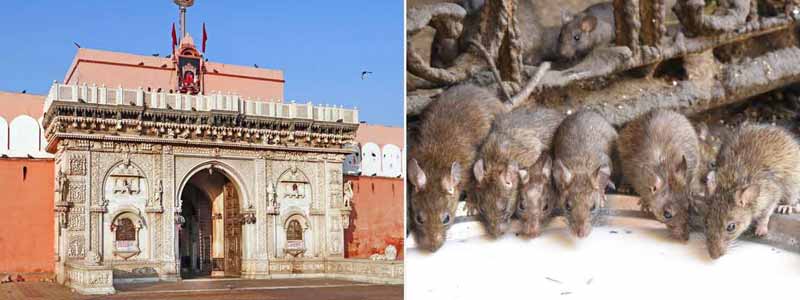
Bikaner
Bikaner, a vibrant city in the state of Rajasthan, India, is renowned for its rich history, stunning architecture, and mouthwatering cuisine. Here are some of the must-visit attractions in Bikaner:
Junagarh Fort: This magnificent fort is a prime example of architectural brilliance. Built in the 16th century, it stands unconquered, showcasing an exquisite blend of Mughal, Rajput, and Gujarati styles. Inside, you’ll find beautifully decorated palaces, courtyards, and temples.
Lalgarh Palace: A remarkable architectural masterpiece, this palace is a fusion of Rajput, Mughal, and European styles. It houses a museum displaying a fascinating collection of artifacts, including royal costumes, weaponry, and art.
Karni Mata Temple (Rat Temple): Located in Deshnok, about 30 kilometers from Bikaner, this temple is famous for its resident rats, considered sacred by devotees. The temple is an intriguing blend of spirituality and unique local customs.
National Research Centre on Camel: Bikaner is known as the “Camel Country,” and this research center is dedicated to the preservation and development of camels. Visitors can learn about these fascinating creatures, their role in the desert ecosystem, and even enjoy camel rides.
Gajner Palace and Lake: Situated on the banks of Gajner Lake, this serene palace was once a hunting lodge for the royal family. The picturesque lake, surrounded by lush greenery, offers a tranquil setting for boating and birdwatching.
Kote Gate: This bustling market area is a shopper’s paradise. It’s filled with vibrant shops selling traditional Rajasthani textiles, jewelry, handicrafts, and spices. Don’t forget to try the famous Bikaneri bhujia, a spicy snack.
Shri Laxminath Temple: A significant Hindu temple in Bikaner, dedicated to Lord Vishnu and Goddess Laxmi. The architecture, intricate carvings, and spiritual ambiance make it a must-visit for religious and cultural enthusiasts.
Devi Kund Sagar: This complex houses several cenotaphs of the Bika dynasty rulers. The intricately carved mausoleums are a testament to the artistic and architectural finesse of the era.
Remember to plan your visit during the cooler months (October to March) to make the most of your trip. Bikaner’s unique blend of history, culture, and natural beauty promises an unforgettable experience for any traveler.
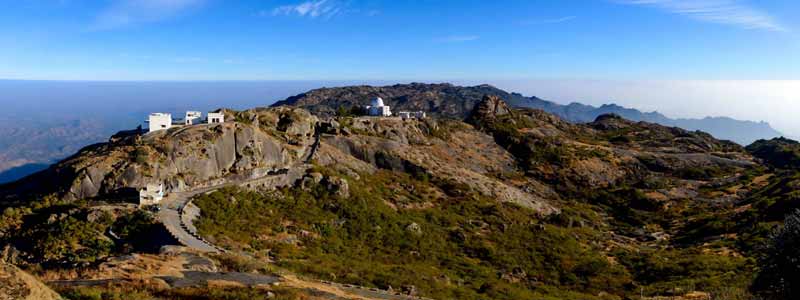
Mount Abu
Mount Abu, nestled in the Aravalli Range of Rajasthan, India, is a serene hill station known for its picturesque landscapes, cool climate, and spiritual significance. Here are some of the top attractions in Mount Abu:
Dilwara Jain Temples: These ancient temples are a masterpiece of marble architecture and a significant pilgrimage site for Jains. The intricate carvings and detailed craftsmanship of these temples are awe-inspiring.
Nakki Lake: This is the heart of Mount Abu, surrounded by hills and parks. Boating in Nakki Lake is a popular activity. The lake is also steeped in local folklore and history.
Achalgarh Fort: Situated at a height of 1,220 meters, this fort offers a panoramic view of the surrounding landscape. It houses the Achaleshwar Mahadev Temple and the Mandakini Lake.
Guru Shikhar: The highest peak of the Aravalli Range, Guru Shikhar offers breathtaking views of the valleys and plains below. It’s also home to the Dattatreya Temple, dedicated to Lord Dattatreya.
Mount Abu Wildlife Sanctuary: Spread over a vast area, this sanctuary is home to a variety of flora and fauna. You may spot animals like leopards, sambar deer, wild boars, and a rich avian population.
Sunset Point and Honeymoon Point: These viewpoints offer spectacular views of the setting sun, making them popular spots for tourists and couples alike.
Adhar Devi Temple: Located inside a cave, this temple is dedicated to Goddess Durga. To reach the temple, one needs to climb a series of steep stairs.
Toad Rock: This rock formation resembles a toad and is a popular spot for trekking and rock climbing. It provides a unique vantage point for viewing the surrounding landscape.
Brahma Kumaris Peace Park: This tranquil park offers a serene atmosphere for meditation and reflection. It’s a great place to find inner peace and spiritual solace.
Shankar Math and Shahi Jama Masjid: These religious sites showcase the diverse religious fabric of Mount Abu. Shankar Math is a Hindu pilgrimage site, while Shahi Jama Masjid is a beautiful Islamic architecture.
Remember to check the timings, entry fees (if any), and local customs before visiting these attractions. Mount Abu offers a diverse range of experiences, from spirituality to natural beauty, making it a must-visit destination in Rajasthan.


